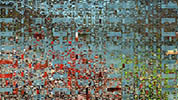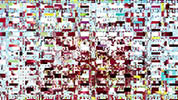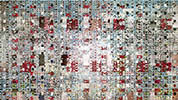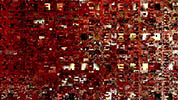


|

|

|

|
Jeremy Hight: "Signal to Noise" is a really interesting play on a kind of intersection between present areas—like glitch—and the history or computing and related areas—television, signal processes, and even back to the weaving loom. Is the aesthetic/semiotics interplay and these points of reference connected to the coding and result?
Casey Reas: While "Signal to Noise" has a clear visual reference to "glitch" I don't consider it to be glitch. It defines a highly ordered and intentional method of assembling images. Like my prior work, the software is a minimal system. Unlike most of my prior work, it utilizes existing media and is not purely generative. At its core, this series is about media and the body. Signals that are continuously flowing through the air and through our bodies are captured through an antenna that is capable of sensing a range of the electromagnetic spectrum that is outside the capacity of the human body. These signals are both obscured and enhanced by custom software; they are pushed to the edge of legibility within the portion of the electromagnetic spectrum that we can sense—visible light.
JH: Your work ties beautifully into computational and computer history. Do you see a bridge from current and future possibilities and the resonance of the past in computer science and art in your work?
CR: I'm trying to break the bridge. To do this, I spent most of 2012 digging deeper into the last century to better understand how to break. The result was the "Century" exhibition at the DAM Gallery in Berlin in fall 2012. "Century" was an homage to influential ideas that defined the major non-objective art movements in the last century.
JH: How is software adding new ways of thinking?
CR: I'm not sure software enables new ways of thinking, but I think it does broaden and popularize known paradigms. Through simulation, software can help people to think about complex and multivariate systems. Writing software encourages people to think clearly and systematically. New telecommunications software certainly changes the way we behave and relate to other people and this certainly affects how we think. This list can keep going, but explicitly interacting with software, writing software, and transparently using software all change our thoughts and actions.
JH: How did your time in the Aesthetics and Computation Group inspire your work and ideas?
CR: It launched my work; it was the catalyst. My obsessions with emergence and kinetic sculpture were fostered in electronics, signal processing, and robotics classes at MIT, but my fellow graduates students and my advisor John Maeda were extraordinary colleagues and guides.
JH: What is emergence? What are some of the exciting applications of flocking behavior?
CR: There are entire books that answer this question; I can't summarize here. The related clichés are "the whole is more than the sum of its parts". It's when two more things are combined and the result is something beyond "adding" the original components. (Water has entirely different properties than separated hydrogen and oxygen.) The original software flocking experiments initiated decades ago were important in understanding decentralized organization. They demonstrated that order in flocks can emerge, rather than one bird or fish acting as "the leader." These experiments were started as biology research. They have been co-opted by other fields.
JH: In one of your talks you speak of working with color as sound and code as score. This is very interesting especially from a cross-disciplinary standpoint. Did early studies of color theory , music or even synesthesia influence your interest in this confluence and way of working with elements of code and design?
CR: What I meant is using color to affect the viewer in the same way that a score affects the viewer of a film. Color and film scores aren't the core of the work, but both strongly influence the emotional tone. Music and color are longstanding strong interests, but I'm not interested in synesthesia, probably because I'm not a synesthete. I have logged many hours watching Fischinger and Whitney films and staring at Kandinsky paintings.
JH: Who were some of your influences?
CR: Wow, this is an impossible list to write. But I can say that it would include visual artists, filmmakers, composers, and architects from the last one hundred years.
JH: What are you working on currently?
CR: Right now I'm finishing up the "Ultraconcentrated" show at bitforms. It opens on Thursday [September 12, 2013]. After that, it's the second edition of the Processing Handbook. I have months of work complete on the Handbook and it's time to edit and write the final chapters. There's a plan to work on a short film and to move into a new kind of work that synthesizes diagrams, cinema, and games.
Casey Reas is a conceptual artist and works in a large area of media and digital related art. He loves to transport things from the Internet into real life and back. Kim did several net art projects, often based on data taken from the Internet or gathered from other individuals through the Internet. His work is experimental with generative strategies, physical computing, data and glitch. Most of his works leads into installations, sculptures, visualizations and abstract geometric art, but also into applications, animated gifs or noisy sounds. In 2010 he coined the term "pixel sorting", an algorithmic image manipulation process with unique results.



 del.icio.us
del.icio.us


